► Best hardcore track car to buy
► Six monsters tested at Silverstone
► Tamed by racing hero, Jamie Chadwick
Just as there are few things worse than sitting next to a driver who scares you, there aren’t many purer pleasures than riding with someone who’s really good at what they do, doing what they’re really good at.
To my left, through the bars of the Ariel Atom’s trellis frame, fresh air. Over my harnessed-in shoulder, the airbox is sucking like a Dyson on overdrive before a visit from your in-laws. And to my right sits W Series champion Jamie Chadwick, steering the Atom as much with the pedals as with the wheel. Chadwick’s not into big slides, except for the camera. Most of the time they’re quelled quickly with swift hands flickering to opposite lock so as not to lose momentum. Right-left esses rush towards us: the Atom enters at a surreal rate, steering wheel pretty much straight, weight transfer doing the work. This is fun.
The best cars on sale today
We’re at Aston Martin’s development base at Silverstone, which uses the tricky little Stowe infield circuit to put its prototypes through seven shades of hell in development. We’ve brought along six very different sports cars, and Aston’s turned the circuit over to us for the day. Each one is fully road-legal but really comes alive on track: Ariel’s barely-there Atom 4, Radical’s barely road-legal Rapture, McLaren’s borderline race-ready 620R, the jewel-like Jannarelly Design-1, the raw Lotus Exige Cup 430 and Caterham’s evergreen Seven, here in rabid 420R guise. There are big differences here in price and approach, aero and engine position, but they’re all outrageously good fun.

To find out which gives the biggest kick, regardless of price, power or tech, we’ve enlisted an expert judge to assist us. All journalists reckon they can drive a bit. But a racing driver can download crystal-clear feedback while we’re still trying to think of clever metaphors, and get to grips with a car within half a lap while most of us are still working out where the track goes. That’s why Jamie Chadwick is here – as an accurate barometer of the cars’ potential, and to give an unflinching assessment of each. When your daily driver is a European F3 championship car and you’re a dab hand at the Nürburgring 24 Hours race, you don’t muck about when passing judgement.
Chadwick’s most well-known for winning 2019’s inaugural W Series, the international single-seater championship specifically for female drivers. But she was also the youngest ever British GT4 champion, the first female British Formula 3 race winner and she’s now a development driver for the Williams F1 team. More to the point, she’s also down to earth, loves driving, and can download her thoughts on the cars with absolute clarity as soon as she climbs out.
‘I can’t wait to get started!’ she says, surveying the pitlane. ‘There are quite a few cars here I’ve never driven before, and this is the perfect track for it. Which one first?’
Jamie’s (very fast) story so far
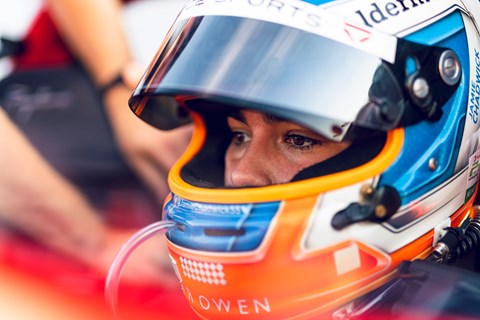
First steps
‘I fell into motorsport pretty much by accident, following my older brother into karting at 12 years old. That’s later than most people start, so I only had two years in karting.’
Ginetta Juniors
Chadwick entered the Ginetta Junior Scholarship instead of an England Under-18s Hockey trial – and won. ‘A great proving ground, which taught me a lot.’
GT racing
From mini Ginettas to V8 Aston Vantage, Chadwick became youngest ever British GT4 champ in 2015. She’s also raced for Aston at the Nürburgring 24 Hours.
Single seaters
‘The step from GTs to single-seaters was a big learning curve. Winning the MRF championship, my first single-seater championship, was a big breakthrough moment for me.’
W Series and F1
Since winning the global W Series championship for female drivers, Chadwick has taken on a development driver role for Williams F1, and currently races in European F3.
McLaren 620R
Essentially the 570S GT4 made road legal and given 620 metric horsepower
Price £250,000
Powertrain 3799cc twin-turbo V8, seven-speed DCT, rear-wheel drive
Performance 610bhp, 1386kg, 2.9sec 0-62mph, 200mph
Read our McLaren 620R review
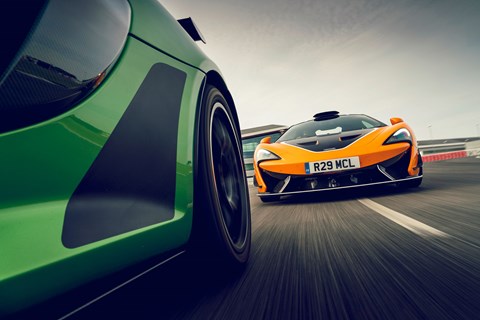
Lotus Exige Cup 430
The most extreme Exige yet: big power, big downforce, and lighter
Price £103,375
Powertrain 3456cc supercharged V6, six-speed manual, rear-wheel drive
Performance 430bhp, 1093kg, 3.3sec 0-62mph, 174mph
Ariel Atom 4
Atom goes turbo, with 316bhp…
Price £39,975
Powertrain 1996cc turbo four-cylinder, six-speed manual, rear-wheel drive
Performance 316bhp, 595kg, 2.8sec 0-60mph, 162mph
Jannarelly Design-1
Retro-futuristic rawness: no servo, no power steering, barely any silencing
Price £89,700
Powertrain 3498cc V6, six-speed manual, rear-wheel drive
Performance 320bhp, 810kg, 3.9sec 0-62mph, 135mph
Read our Janarelly Design-1 review
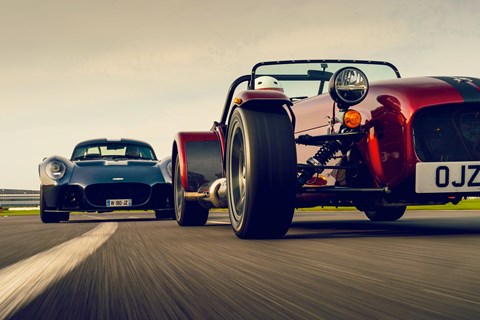
Caterham 420R
The 2.0-litre Seven in R spec, with track-focused suspension, diff and seats
Price £35,490
Powertrain 1999cc four-cylinder, five-speed manual, rear-wheel drive
Performance 210bhp, 585kg, 3.8sec 0-60mph, 136mph
We live with a Caterham Seven
Radical Rapture
Looks like it’s escaped from a race – very much has
Price £107,400
Powertrain 2261cc turbo four-cylinder, six-speed paddleshift, rear-wheel drive
Performance 360bhp, 765kg, 3.0sec 0-60mph, 165mph
Fast meets fastest
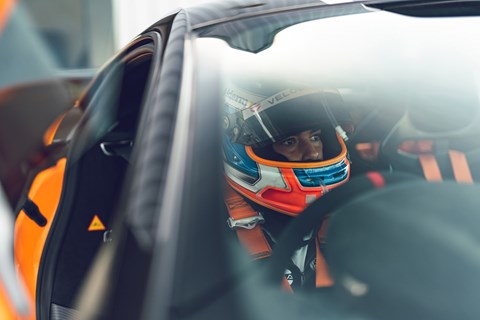
Let’s start with – and rewind back to – that Ariel. This is the Atom 4, lower, wider and stiffer than its predecessor but just as delectable to behold. A kind of rolling cutaway drawing, it’s a little like a high-end sportsbike to walk around and admire, drinking in all of its componentry. Tucked away in the middle is a turbocharged Honda engine plucked from the current Civic Type R. The high-pitched yelp of a supercharger was a hallmark of previous top-spec Atoms, and I’d wondered if the 4 might have lost that character in its transition to turbo power. I was wrong. All kinds of tweets, squawks, hisses and flutters emanate from the engine bay. It sounds like there’s a whole pet shop in there. Who knew all of that was going on behind the bulkhead of a Type R? The five-door Civic already feels monstrously fast – in a car that’s half the weight, the turbocharged Honda four feels explosive.
It’s the first time Jamie’s driven an Atom, and she’s impressed. ‘That’s… punchy,’ she says, approvingly. ‘At least, it’s punchy until you run into the limiter. It feels like the gearing’s too short for the car and the turbocharged power band is weird. You want to keep revving but then it hits the redline, so you find yourself changing gear all the time. The pedal positioning is perfect, though; great for heel-and-toeing. I like it.’
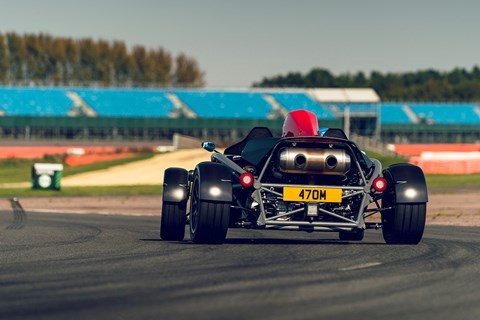
Into the driver’s seat for a turn. The steering strikes you immediately – unassisted yet light in weight (hardly a surprise with so little mass over the front tyres) and mainlining confidence-inspiring front-end grip to your fingers and palms. The balance is ever so slightly understeer-biased in this baseline (and tweakable) set-up but, crucially, rear grip is stable too. You’re never in any doubt about what the rear axle’s up to (or what it’s about to do). Original Atoms could be tricky on the limit, but the 4 feels seriously well sorted. Its handling is as transparent as its see-through structure.
I could happily stay in here all day, but there are five more cars to get through – starting with the McLaren. It’s twice the weight of the Atom, with more power, more aero, more… everything. The 620R is the closest thing possible to a road-legal GT4 racer. It’s even designed to run either road-legal tyres or slicks on the same-size wheels: simply unbolt one set, bolt-on a stickier one. The Radical Rapture could perform the same trick but, like the rest of the cars here, it’s on road-legal tyres. With that in mind, we start the 620R on its road-spec Pirelli Trofeos to begin with, to see how they compare and contrast.
The McLaren’s fast and great fun. The best lap time comes from being neat and tidy but the McLaren’s happy for you to lean on it and over-drive it a little. It won’t bite, even with its stability control in lenient Track mode, or switched off altogether. Just like the GT4 racing car the 620R’s bodywork and hardware are so closely related to, this McLaren is absolutely consistent: it responds in the same way every time and gives you the confidence to push harder and harder each lap.
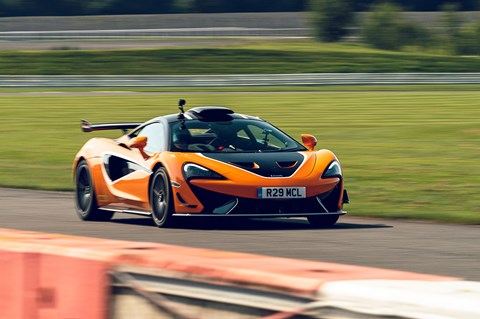
It’s a trait Jamie applauds. After a slow sighting lap, we hear the revs soar out of the hairpin, wheels spinning as the turbos come on-boost. She’s trying different lines each time, the McLaren’s tail gradually arcing wider as she lets it blend into oversteer. The 620R’s getting looser as the tyres get hot, Pirellis scribing black lines onto the tarmac like a charcoal sketch.
When we wave her down, heat spilling from the car’s brakes and vents, she instantly downloads a stream of feedback. ‘Even in Track mode the ESP cuts in too much – it needs to be off completely. The chassis’ response to steering input is absolutely instant, which is good – unusual for a road car – but you have to wait for the tyres to catch up. It feels like it needs the slicks to come alive. Anyway, I need to go and cool these brakes down…’
The 620R purrs off for a cool-down lap and then to swap for slicks. Re-booted, it sets what turns out to be the quickest time of the day (if only a fraction ahead of the road-tyred Ariel and Radical). ‘With the slicks on, it’s a different car,’ Jamie says. Close to a full-on GT4 car? ‘Very close, especially on the brakes and turn-in. More like a GT racing car than a trackday car, in fact. It’s very refined; perhaps too refined if you’re after something raw and really exciting.’
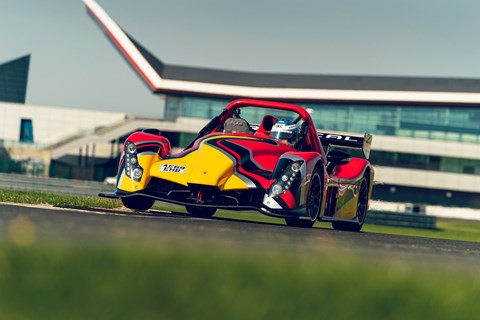
It’s hard to think of a car more raw than the Radical Rapture. If the McLaren is only one step removed from a pure race car, the Rapture is even closer to its original source material. It feels incongruous to see number plates on the car, and to climb into the open cockpit – with leather trim! – and find a handbrake. The spaceframe chassis and composite body are both closely related to Radical’s hugely successful – and hugely fast – SR series of racing cars, and while the Rapture’s fully road-legal, it’s very much at the drive-to-and-from-the-circuit-only end of the scale. Power comes from Ford’s 2.3-litre four-cylinder turbo as seen in the Focus RS, but uprated to 360bhp (in a car that weighs 765kg…).
You sit in the middle of the car, but it feels almost as if you’re over the front axle, like an astronaut at the tip of a ground-level, horizontal rocket. Handy reversing camera aside, the cockpit feels like a Le Mans-style prototype. The paddleshift gearchange emits a pneumatic pfft-ting as you engage first gear and the clutch pedal is heavy as you pull away (once above cantering pace in the pitlane, you needn’t touch it again). The Radical should feel intimidating – and it does at first – but the car is actually on your side. It’s honest and friendly, not least because it has the greatest clarity of feedback of all the contenders here, more kart than car.
After putting you at ease, it eggs you on to try a little harder. There’s a bit of understeer at the first hairpin through the relatively weighty, unassisted steering, but massive traction on the way out. The road-legal Yokohama tyres hang on well as they get hot, and the sequential gearbox is fantastic fun, crisply matching the revs with every downshift. Jamie’s impressed with the gearshifts too, although she notes that the wind rush and turbo whoosh take away the engine noise when you’re inside the car, leaving you dependent on the shift-up lights to time your changes.
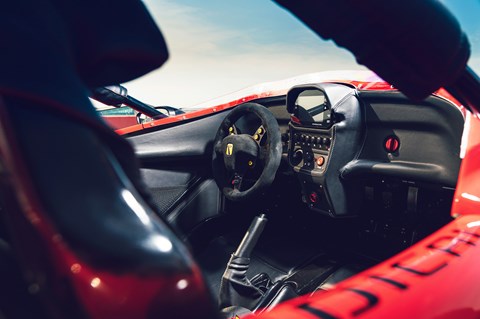
‘When a car sounds fast, it feels fast,’ she says. ‘You don’t get that so much with the Rapture.’ It’s deceptive in that regard: you’re well into sixth gear on Stowe’s back straight – and it’s not that long a straight. I can’t imagine how it must feel on the road. Mind-altering, I imagine.
Stowe doesn’t quite feel the right setting for the Rapture to stretch its legs. ‘Really strong brakes, great gearbox, but it would be better on a longer, faster circuit, where you could use the downforce,’ Chadwick says. ‘You need more momentum than you can get here. But somewhere like Spa…’
If the Radical needs high speed to do its best work, the Caterham 420R is the opposite. ‘If I was going to do a trackday, it’s the car I’d pick,’ says Jamie, who’s spent a fair few miles in Caterhams, some of them racing. ‘You can drive under the limit, over the limit, and it’s always enjoyable. And you’re in an open environment, which adds to it. When it’s not raining…’
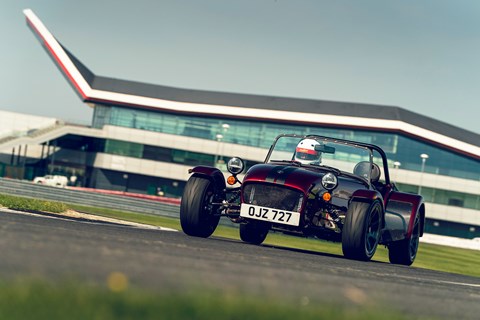
It’s definitely not raining today, and heat spills from the Caterham’s
bazooka-like side exhaust onto my bare arms. Even when you’re being lightly toasted by sun, windburn and silencered heatgun, the Seven is accessible and huge fun. Sitting inches ahead of the rear axle, its limits are lower than almost all of the other cars here but that means you’re never in doubt what it’s up to, nor in any doubt of catching it as it lets go. There’s more bodyroll than most of the other cars here but it’s no bad thing; it helps you gauge what the Seven’s up to.
If the Seven feels like home, this one offers more generous accommodation than most thanks to its wider SV chassis. Jamie describes herself as ‘excessively short’, and this broader-of-beam Seven gives her an awkward angle on the wheel, pedals and gearlever, and makes heel-and-toeing an impossibility. Even so, she wrestles it to a quick lap time and some entertaining angles. ‘It’s perfect for this track; great to throw around,’ she grins.
If the Caterham’s a home from home for Jamie, the Lotus Exige is new territory. And this is the ultimate Exige: the Cup 430 is the most powerful, most expensive and most ruthlessly stripped-out version of Hethel’s hairiest car. The gearchange mechanism looks fantastic, exposed to the open air like Arnie’s arm post-surgery in The Terminator, but the action is similarly stiff. I find it easy to miss gears unless you punch the weighty clutch pedal right to the floor and are slow and emphatic with the lever.
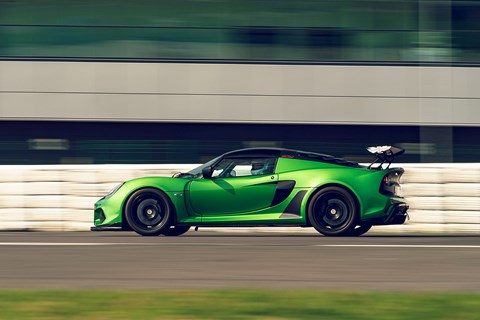
Jamie finds it obstructive too: ‘Surely they could have engineered a lighter gearchange?’ In all other respects the Exige is anything but obstructive: the brake pedal relays so much feedback you can take the brakes j-u-s-t to the point of ABS intervention, and it always feels balletically poised and nimble. It pogoes on its springs a little in the curved braking zone for the first hairpin, which I initially find disconcerting, but Jamie’s fine with it: ‘That’s okay, you can use that weight transfer.’ As the corner unfolds to its exit, however, the Lotus is less okay. With the traction control off, the inside rear tyre squeals and the Exige wheelspins its power away. It doesn’t have a limited-slip differential, an Achilles’ heel that this track layout brutally exposes.
‘That’s really good. On the way into all the corners the Lotus is the best-balanced car here,’ Jamie says. ‘It’s really reactive, and you can place it exactly where you want. It’s almost like a little race car in that respect. But the way it spins its wheel makes it really difficult in the second part of a corner. Into the corner it’s perfect, but on the way out…’
The Exige fights back with a secret weapon – a race-derived traction control that mimics a locking diff. Turning a knurled aluminium wheel on the steering column allows six levels of slip. In a mid setting, the Exige scrambles out of the slower corners more easily, although without quite the alacrity of a mechanical locking diff. In every other respect, however, it’s ferociously, addictively capable. And, with the V6 singing its heart out through titanium pipes, it sounds fantastic too.
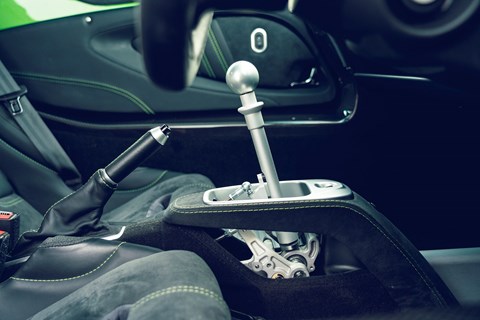
In fact, it’s hard to imagine a better-sounding car in the world than the V6 Exige – until the Jannarelly Design-1 fires up. You’d never guess its 3.5-litre V6 comes from a Nissan saloon (and the old 350Z). Or, given the bonnet’s shape, that it’s mounted transversely behind the seats. It sounds, and looks, like it’s just driven off the grid at the Goodwood Revival, a sort of steampunk retro-modern barchetta.
The Jannarelly is an outlier in our all-British line-up. It’s a citizen of the world, part French and part Emirati but available in right-hand drive in the UK. ‘This is interesting,’ says Jamie. ‘The design puts me in mind of a Jaguar E-Type.’ There are hints of AC Cobra, too; she sets off and it sounds more raucous even than a race-spec Cobra. Every head in the pitlane swivels around to watch and listen, and I jump in the Atom to follow. I can hear the crispness of the throttle response as Jamie rev-matches on downshifts, and in big braking zones the Jannarelly’s exhausts turn into flamethrowers, spitting fire.
She’s climbing out as I return to the pits. ‘Phew, that’s physical to drive. I’ve got a sweat on! Its limits are low, but it doesn’t have any vices to catch you out. It rotates really well – it’s just lack of traction holding it back. It feels almost like a historic car to drive.’ (Jamie’s CV also includes racing a Jaguar E-Type in the Spa Six Hours endurance race).
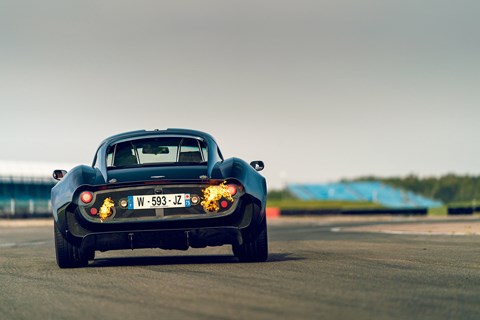
I can’t wait for a go myself. Forward-hinged hardtop tilted aside (it’s an optional extra, and so is the windscreen), you open slender, half-height doors and step over broad sills into an objet d’art cockpit. The dials look like chronograph watch faces; the gear linkage, like the Lotus, is an exposé of machined metal. There’s no servo assistance for the brakes, nor power steering, and it’s just as physical an experience as Jamie suggests. Physical for your eardrums too – comically loud (more so on the inside than the outside), yet the sound is so evocative you don’t mind. It does feel like a classic car to drive – lots of big steering inputs to maintain a smooth line, and brakes which, in Jamie’s words, don’t do a huge amount, so you use engine braking as much as the middle pedal to slow down.
With its dampers in their softest setting the Jannarelly’s less agile than the others but it’s also by far the most road-orientated car in the line-up. The limited-slip diff it really needs (like the Lotus, it lights a ‘one-tyre fire’ on corner exit) is an option, and so are uprated brakes, and more or less anything you want as long as you’re prepared to pay for it. Jannarelly aspires to a similar tailor-made mentality as Koenigsegg or Pagani. Paint colours are removed from the palette once ordered, so no two of the 499 Design-1s to be built will be the same hue. Jamie sums it up: ‘Rather than the way it handles, the big thing about it is the way it is – a beautiful car to be in and to drive.’
Six very different, very rewarding cars, then. But which one wins?
Best track car 2024: lap times
We’ve used Silverstone’s Stowe circuit for our track test, home to Aston Martin’s testing centre.
Just two-tenths cover the top three. The McLaren is the only car here on slicks but it’s only just quicker than the featherweight Atom and Rapture. Were this a faster, more flowing track, the Radical’s downforce may have elevated it to the top of the table.
McLaren 620R: 54.60sec
Ariel Atom 4: 54.71sec
Radical Rapture: 54.78sec
Lotus Exige Cup 430: 58.42sec
Caterham 420R: 59.22sec
Jannarelly Design-1: 1min 3.2sec
The best of a wild bunch
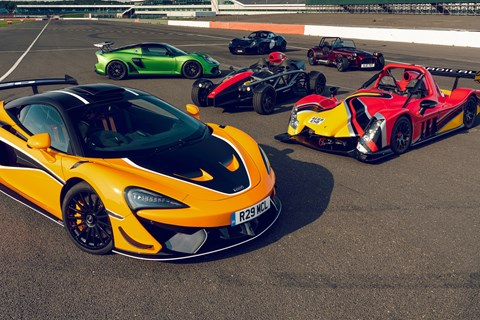
So, a winner. It’s easy to love the Jannarelly – Jamie falls for its glorious sound – and of all the cars here, it’s the one I’d put in my lottery garage. But it’s not the one you’ll most want to keep lapping until it runs out of fuel; it’s not quite precise enough, doesn’t quite give you back what you put in, even if it does put a gigantic grin on your face as you work away at its wheel.
‘I didn’t feel I could push the limit in it – it’s more about enjoying the experience,’ Jamie says. ‘The rear is very progressive, so you can release the brake and it rotates into the corner, which is really nice. But on the downside, that means traction is… poor,’ she grins.
If a shortfall of grip holds the Jannarelly back, does that mean the cars at the more track-focused end of the scale, the Radical and McLaren, edge into the winner’s circle? Not for Jamie: ‘On this track the Radical was actually a little underwhelming, because it couldn’t maximise its potential. In any downforce car, you don’t really play around with the limit of the tyres’ grip, which, if your aim is having fun on a trackday, maybe isn’t ideal.’
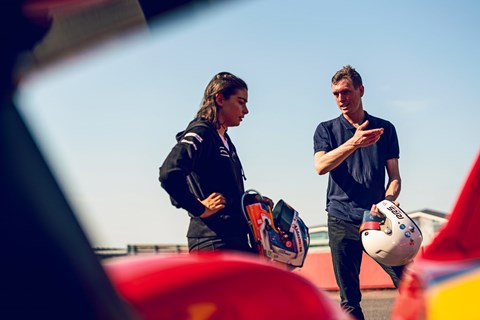
The McLaren, on the other hand, is just so sorted it leaves the driver with less to do. ‘The first time you drive it you think, “Ah, this is fun,” because you’re up to speed straight away,’ Jamie explains. ‘But hit the brakes and you’ve got ABS, stamp on the throttle you’ve got ESC… You can’t really get anything wrong. So it’s confidence-inspiring, and I’d say it’s the best in terms of outright performance. But I think it’s also a bit… numb.’
I don’t drive an F3 car for my day job, so both the Rapture and 620R’s absolute precision and performance impress me more than they do Jamie, and I glean more excitement from both. But I think she’s right; for a purely recreational track car, perhaps something rawer is ultimately more rewarding.
Which leaves three cars: the Lotus, the Caterham and the Ariel. ‘I would have gone with the Exige as the winner but the lack of a locking diff really spoils it. It makes a massive difference. And it’s a little bit too physical to drive – I was having to work quite hard with that gearshift; after a full day on track, you don’t want to feel like your arm’s going to fall off.’
I agree; I loved the Lotus from the moment I first tested it, and I’m still captivated. But the traction issue really does hold it back.
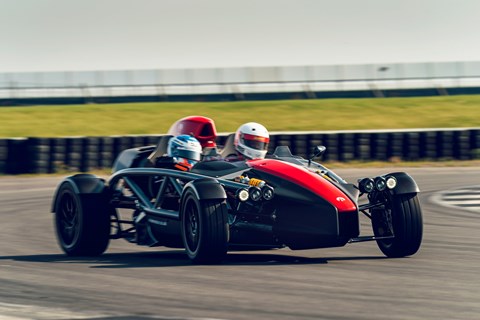
Caterham or Atom? For Jamie, it’s the Caterham 420R: ‘Where the window to finding the limit in the McLaren is like this,’ she says, miming a small aperture, ‘in the Caterham it’s like this,’ expanding her hands like a fisherman describing the biggest catch of his career. ‘At any speed, on any type of track, and for sheer fun, it’s everything I want.’
I love the Seven wholeheartedly too but, on this track in this weather, the Atom is the car I most want to drive more. And even though Jamie plumps for the Seven, she’s impressed by the Atom: ‘You really feel the speed, more than the other cars here. And it’s quite playful, so it rotates well through the twisty stuff, even if it’s not so easy to play with in the high-speed corners.’
A challenging plaything, it’s our winner. For heart-in-mouth speed with hand-in-glove feedback, it’s our favourite road-legal track car.
With thanks to Aston Martin for the use of its Silverstone test track – Valkyrie for the win next year?